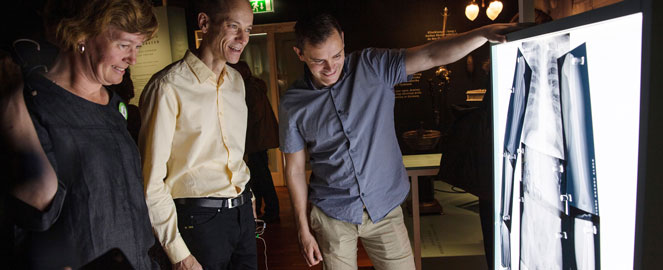DNA CHIPS AND DENTAL CARE

The theme of the exhibition is how the Danish health system has developed over the last century.
Most of us take the Danish health system for granted. We call the doctor when we are ill. We are offered vaccinations, school-based dental care and other forms of preventive measures. But in reality, the Danish health system has developed in such a way that we have reached a consensus that preventative measures and treatment benefit not only the individual, but society as a whole.
The exhibition explores how healthcare became communal, and allows one to contemplate:
- That during the 20thcentury, healthcare and medical help became a national undertaking, offering free preventive measures and medical help to all.
- That technology has played a crucial role in this development.
- That several dilemmas have arisen during the development of the health service, which has as an ideal that everyone should be treated equally and receive the best possible treatment.
‘Sick-boxes’ – Community health care
All Danes have the right to free medical treatment. It is our yellow health cards that give us access to treatment, and it is all financed by the taxes that we pay. In this way, we collectively ensure each other’s health. It began at the end of the 19thcentury, when workers united in small associations, where people were collectively insured for medical treatment when ill. These associations were known as ‘Sygekasser’ (lit. ‘sick-boxes’). Each association worked together with several doctors, known as ‘sick-box’ doctors.
The exhibition shows the clinic of Mathias Agerley, who established a practice at the start of the 1900s.
Prevention: From dentures to teeth for life
Daily tooth brushing is a relatively new phenomenon in Denmark, as are the white, clean, intact teeth that many Danes keep well into old age. This has been a crucial factor for our national health. Around 1900, nine out of ten children had untreated cavities. It was not unusual for young people to have all their teeth pulled out and get dentures as a confirmation gift, around the age of 14.
The exhibition features the reconstructed interior of the first school-based clinic, which opened in Aarhus at the start of the 1900s.
Our voyage into the living body
We have become increasingly skilled at looking inside the body. Before 1900, it was hard for doctors to examine their patients, as they had very few tools. The discovery of X-rays in 1895 launched a scientific voyage into the human body, revealing bones and tumours hitherto unseen. Later came special optic devices that could take pictures of the stomach, intestines and lungs. Today, we not only check sick bodies but healthy bodies too, to prevent cancer and other serious diseases. That is why many Danes are invited to take part in ‘screening programmes’, which test large population segments for a specific illness. In Denmark, new born babies are screened for 16 inherited conditions.
In the exhibition, guests can experience medical equipment from a wooden X-ray machine used in the first TB screenings, to modern optical microscopes and DNA chips.
Difficult decisions
We keep getting better at detecting and treating disease. We keep seriously ill people alive longer, and save extremely premature babies. Medical progress is rapid, forcing us to face numerous dilemmas – we have finite resources and need to make priorities.
In the exhibition, guests are invited to consider three authentic and current dilemmas from the Danish health service. They concern prioritising medicinal supplies over staffing levels, the scarcity of donor organs for severely ill patients and the seemingly endless possibilities of finding mistakes in our genes via genetic testing.
The dilemma is brought to life with the help of authentic objects and the possibility to vote in ‘The Price of Health’. Guests, with the help of a miniature health card, can choose two out of five commonly expressed wishes that the public have for the health service and the politicians – for example more urgent treatment for young people with mental problems, better staffing levels in geriatric care, easier access to doctors in outlying regions or new life-prolonging medicine against cancer.